Trailer
Contemporary staging does not particularly favour the fantastical. We can read or reread the review of Tcherniakov's 2024 production at the San Carlo with Asmik Grigorian… as a synchronised swimmer.
Netia Jones, who directed Le Nozze di Figaro at Palais Garnier (Paris) in 2022 and will be staging Antonia Bembo's Ercole Amante in the spring at Opéra-Bastille, shakes up the glitter of the fairy tale but retains the dreamlike atmosphere by adding superimposed screens and videos, since screens and images are the best providers of dreams and fantasies in everyday life, and in high doses in the evening.
This layer, or rather these layers and overlays, dress the stage, change its ‘reality’, create relief effects (video on video) and further disrupt our relationship with what is being performed. The effect is skilful and far from being reduced to a simple new video. There is something foreign that slips in and interposes itself in our reality, disrupting our ways of seeing, filtering them. This is the subject of Rusalka, an undine who wants to escape her condition and seek human love, a mirage. We see that the most important themes of the libretto of Rusalka are treated in this way, displaced but almost always dissected (such as the desire to have a soul, from a Christian perspective).
So, at the beginning, there is chaos, a maelstrom, a whirlwind of videos that plunges us into an underground, aquatic universe with an indeterminate female figure. It is Rusalka, but it is undoubtedly also the young girl, in general, lost in this ocean of images. We know that young girls are more subject than boys to the dictates of social media.
Gone are the enchanting nature and nymphs. Here we are in a cesspool, a gloomy underground world, an engine room, in a labyrinth of pipes. We are in a world of flow, of raw materials (here water) and information, at right angles, since everything is supposed to be binary (good/evil, human/supernatural…). In this labyrinth, which presents itself as a cage, a prison space but which is also a play space (the squirrel cages in school playgrounds), it is no longer nymphs but nymphets who twirl deftly, caught up in this role, which they have accepted as such, like cosplay (the Japanese nymphet, pleated skirt and white shirt, childish and sexualised).

In this universe of not-so-innocent games, the Ondine appears, like Wagner’s Alberich in The Ring, here as a plumber. At first glance, he is a fallen figure, certainly, but he is also a hero : that of Super Mario, Nintendo's heroic plumber, hero of several generations, in his universe of pipes and plants, bosses to defeat and princesses to save. The heroic plumber is also Tuttle, played by Robert de Niro in Terry Gilliam's Kafkaesque nightmare Brazil (1985), working for a good cause and saving the little people. In the film, he is a proletarian hero and an outlaw… because he loves a job well done in a world of rules, Kafkaesque and unnatural. And in Netia Jones' production, which follows Rusalka's libretto more closely than it appears, we find the opposition between two worlds : that of the state of ‘nature’ (the plumber, the nymphets, the idealistic lover Rusalka…) and the world of social rules (the masters of the world above, the Prince and the foreign Princess, above the hierarchical world of valets, Marmiton, the gamekeeper, etc.), the two worlds being doomed to remain separate, which is sensed by the Ondine, a connoisseur of flows, master of the liquid element, who can repair material things (he seals pipes) but already foresees that he will not be able to repair the delicate machine that is his Rusalka's heart.
Rusalka wants to leave the narrow and unattractive world of the lower classes to find a little light and acquire a soul. The sign is ominous, as it is in the moonlight that Rusalka addresses her prayer.
Here, we see a video of an ascent to the surface reminiscent of that of Bill Viola, master of ritual and transcendence imagery, for Sellars' production of Tristan und Isolde at the Opéra-Bastille and elsewhere. Other images by another visual artist follow, as Netia Jones uses carefully chosen lighting to transform the stage into the icy world of Robert Wilson : sharp, cold lights and varied shadows.
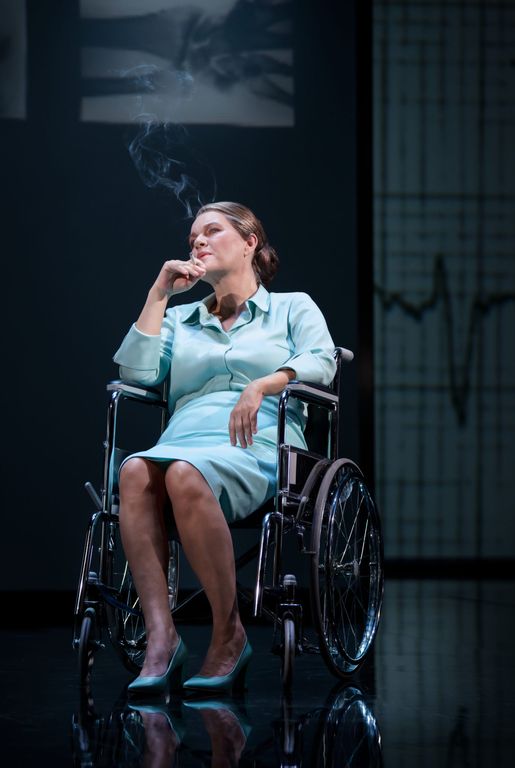
A world of witchcraft takes shape, as threatening as Jezibaba's hut : the clinic, not very Catholic, where unnatural acts seem to be accepted. The witch, incidentally, consults with a cigarette in her mouth. That's how serious it is… A symbol of pharmacy, the illuminated cross reminds us here that Rusalka is also seeking to win a soul.
Images à la Robert Wilson, then, but also à la Damien Hirst, who, at one time in London, designed Pharmacy, a bar-restaurant, an ode to medicines – that modern magic – where pill boxes, pills and the clinical atmosphere embodied the ultimate in trendiness.
A diversion of diversions, Rusaka seeks a soul, she says, but Jezibaba works on the body. The change of environment only affects appearances in this production, relegating the possibility of transcendence to a meaningless commercial symbol (the pharmacy cross) or simply denying it.
In another forest, reduced to its symbols (videos of trees), the Prince hunts the maiden and finds Rusalka leaving her clinic in the form of a bimbo inflated with silicone and Botox. A woman augmented by impoverished transhumanism.
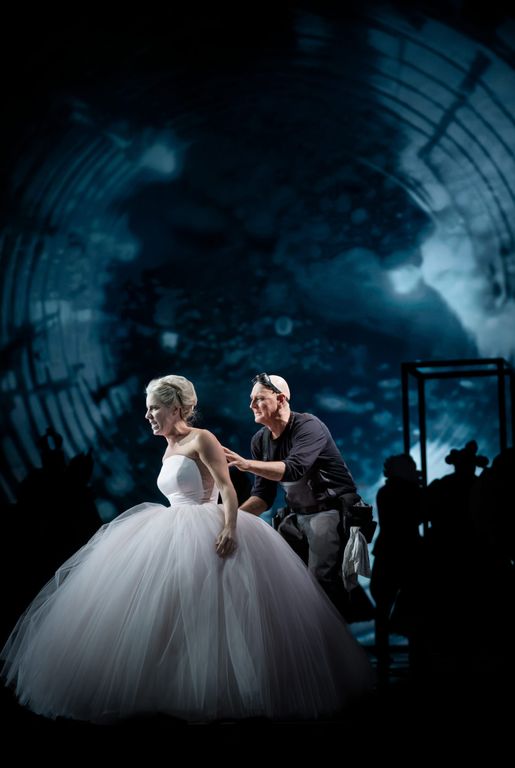
The water sprite in search of love and humanity is seen by Netia Jones as a girl from the slums, seeking to become a woman, or at least buying the canonical attributes of ‘the’ desirable woman to seduce the Prince. This enhanced, denatured Rusalka is mute (this is the condition of the magical transaction in the libretto) and, Netia Jones seems to be telling us, because this world loves sexually attractive women, she needs a ‘perfect’ body (ahem…) without a soul and without expression. Rusalka is caught between two worlds and unsure of herself in this new body that is not her own. She staggers on her high heels (a transmutation of appendages : fins versus high heels) and almost turns her back on us, obscuring her face and revealing only a clumsy but generously proportioned body, highlighted by the three-quarter length. Rusalka has become the voiceless soprano, the bimbo foil for screens and salons on the arms of powerful men. And she is another fairy-tale creature. We think of Daryl Hannah in Splash in 1984, another version of Andersen's Little Mermaid, opposite her beloved Tom Hanks in a modern fairy-tale New York.
Act II
Netia Jones works on Rusalka's body and flesh. The scene with the Forest Ranger and the Kitchen Boy is therefore moved to another space, adjacent to power and serving it just like the pipes in Act I : the kitchen. Here again, it is a question of treating living creatures and accommodating them to the prince's pleasure, echoing Jezibaba's clinic. The same cold stainless-steel universe, the same bodies treated like… meat. Rusalka casts mirrored glances at the headless carcasses that furnish the kitchen.
The main officiants (the Forest Ranger and the Kitchen Boy) are unambiguous, dressed in blood red, unlike their assistants, who are dressed in traditional white. Here again, other cinematic memories come to mind : those of Cronenberg's Dead Ringers (1988) with Jeremy Irons, playing two deranged twin surgeons in curious red clothes. Something is not right in this business, both at Jezibaba's and in this castle.
The worm is in the fruit, Rusalka of course, but also the foreign princess, all curves and ease – she is of this world – swaying from the kitchen to the ballroom while Rusalka is stiff and awkward in her beige sheath dress.
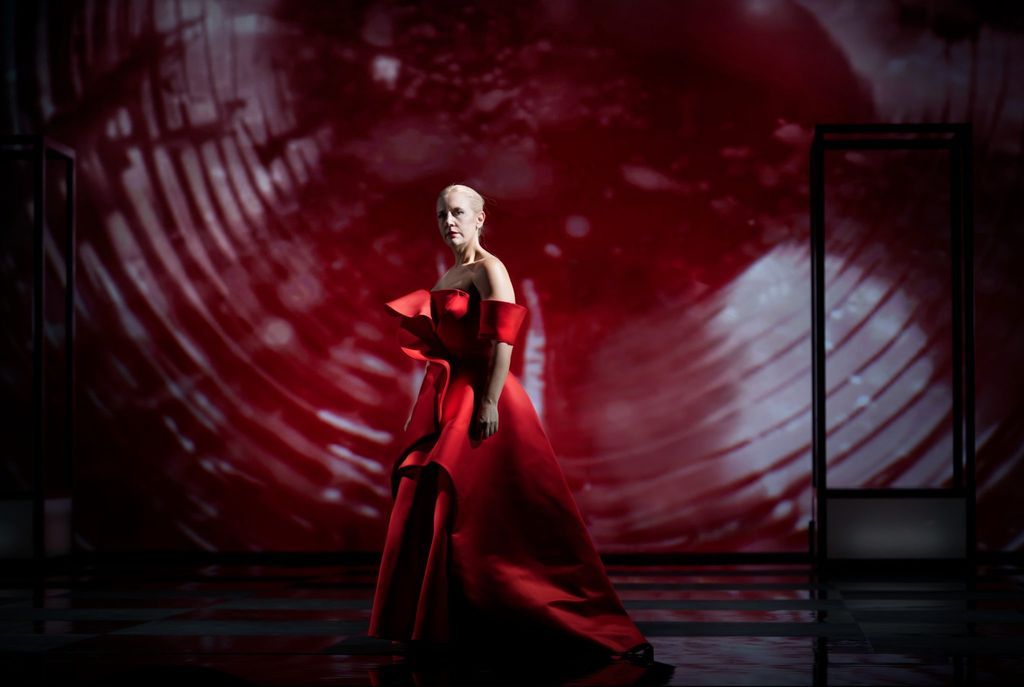
The Foreign Princess is the mistress of the house, the mistress of the game, including when she gives Rusalka the wedding dress that will adorn her for the ball. The Foreign Princess knows she cannot lose (if not win). So it is a game of social demolition that is being played with Rusalka, a class defector, a dog in a game of skittles.
This is the ball scene, with ballet music treated in a very playful way by Netia Jones, like a game of chess (they are all losers) where the guests enjoy playing the pieces on a chessboard. It is therefore a social game, with its precise rules and precise movements (we find the effects of symmetry from the world below). There is less wriggling than with the nymphets, but it is more fun. The reds face off against the blacks. The foreign Princess is passionate red, of course, while the Prince in his tuxedo is both black and Rusalka, in a puffy white dress, a real meringue, an extra piece in this well-oiled game. Rusalka, too ethereal, cannot satisfy the Prince's carnal desires, and he rejects her and is rejected by the Foreign Princess, who is too jealous.
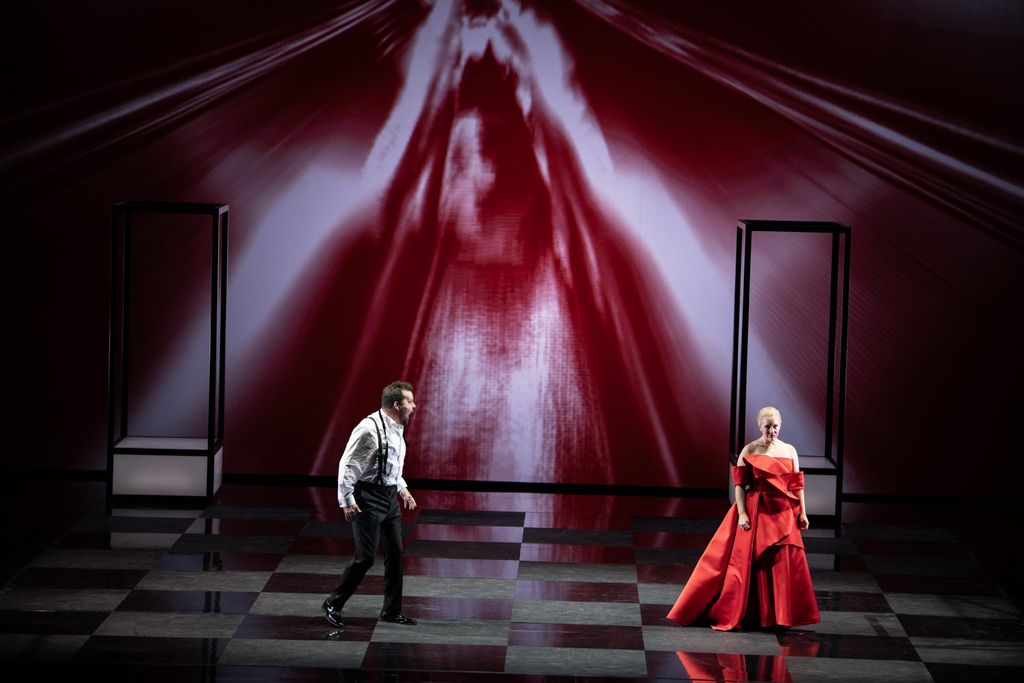
Here we see the themes of the video : the black moon, which previously heralded disaster, now shows the eclipse of love, one replacing the other. The foreign Princess completes her evil work (lunar influence, symbol of inconstancy, for a role like the Queen of the Night) by leaving the unfortunate Prince. Everyone loses in this game (it is the nature of games to always have at least one loser), including the plumber-ondine who had resurfaced in the blower's hole (still following the trail of the underlings) to console his Rusalka.
Act III
Rusalka then finds the Witch engaged in her dirty work : she disposes of her bags of surgical waste herself, which do not appear to be sorted but rather emptied into a sewer, returned to the sender in the domain of the water sprite Super Mario. Nothing is lost, nothing is created, everything is transformed, as Lavoisier said…
The Witch offers Rusalka the choice of returning to her original form with the help of the prince's spilled blood, or poisoning him (she takes a metal syringe out of her yellow bins before taking out a knife, which is more practical), since everything in Jezibaba's world is nothing but rubbish and death. We remember that, in her clinic, apart from the pseudo-success Rusalka, there seemed to be only patients in poor health, waste, bits of flesh, ending up as rubbish in the cellar ducts. Changing oneself, aspiring to a better social status, hoping for love by tampering with one's own nature down to one's flesh, condemns one to unremitting unhappiness.
This is still the meaning of the lunar eclipse, which reappears to take on various meanings, here the masculine sun hidden by the feminine moon : the unlucky day, the return of Seth to Earth for the Egyptians according to Plutarch, explaining the prince's melancholy.
While the nymphets have replayed their playful part based on childish antics in their world of pipes, the prince appears degraded : gone is the tuxedo, he is now wearing a comfortable hoodie and drinking from a bottle. Still a sickly appetite for liquid…
The two impossible lovers unite one last time in a kiss, without redemption (Dvorak's tale is clear on this point, and Netia Jones, in her universe without transcendence, respects this) and leading to death : the prince swallows his wine laced with pills gleaned from Jezibaba, always that witch's poison, bringing only death and desolation.
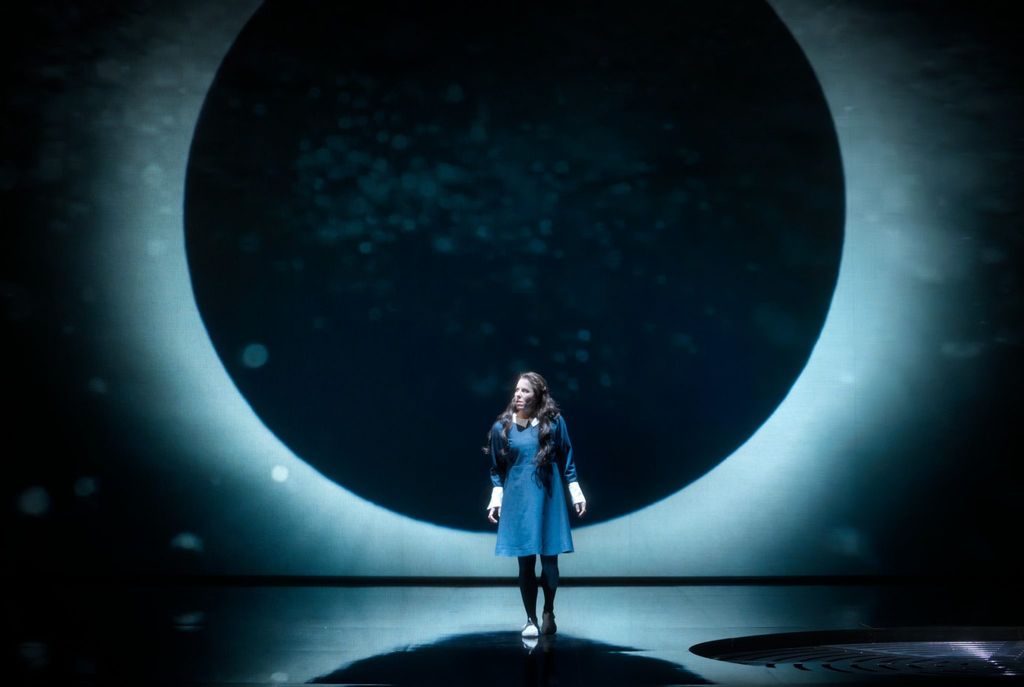
As our editor-in-chief, Guy Cherqui, points out : ‘Rusalka is not a fairy tale, it is a tragedy made all the more violent by the fact that Rusalka is also denied a noble ending as a tragic heroine’.
In short, the dark tale by Dvorak and his librettist Jaroslav Kapil, stripped of its natural ‘wonder’ but drawing, in Netia Jones' version, on the performing, visual and cinematic arts, is well suited to our dry and violent era, where young girls' dreams reek of standardisation : advertisers and predatory companies, at this time of year, offer cosmetic surgery deals for the festive season on public transport… With, ultimately, an invasion of duck-like puffy lips. Deleuze's animal future takes a (lead) blow to the wing…
Without revolutionising the reading of the work, Netia Jones' production works well and gains above all from its technical capabilities in terms of video (double screens) and lighting, which bathe the stage in a nightmarish dreamlike atmosphere (unless it is the other way around). We remain cautious, even undecided, about the videos of this young girl, whom we associate with Rusalka. Is it still the character or the girl in her essence ? Is it a nightmare ? Is it retrospective (the girl seems to be floating, drowned, at the beginning) or not ? These are all questions that we will try to answer during the revivals.
Set design, musical direction
The set, while not flamboyant, is perfectly adequate. This is particularly true of the members of the troupe. It is always a pleasure to see Vivianne Holmberg as a nymph or Kristian Flor as Ondin. The latter, with his beautiful, deep and finely crafted voice, is always charming. It is more in her performance as a low-level witch, with her impeccable stage presence, that Katarina Leoson stands out. Her line wavers a little, some of her high notes are shrill, but what a performance as a vulgar and active woman of power. Special mention goes to Ebba Lonjonclou as the kitchen boy, another character sketched in a few notes and gestures but very assertive on stage with a very clear voice. We are delighted to see Julia Sporsén return as the foreign princess, dazzling as Norma at Folkoperan in 2022 and whom we had tracked down earlier this year in Gothenburg as Desdemona, sadly ill that evening. Impressive in her presence and poise on a stage she occupies without needing to pace, she is the perfect counterpoint to Lauren Fagan's Rusalka. And of course, she has the right voice, with generous volume and colours that unfold like passionate fireworks, to stir a prince who is somewhat numb with cold.

The heroic tenor Prince without glory must still arouse interest, and Brenden Gunnel (heard by our editor-in-chief as Siegmund in Gothenburg in 2020) succeeds with great brio, beautiful phrasing and very distinctive colours in all shades. It is a rather thankless role and it takes a lot of musicality to embody it, which he does.
Finally, Lauren Fagan, Norma in 2021 in 7 Deaths of Maria Callas at Opéra-Bastille in Paris, captivates with her warm voice, deep low notes, high notes that rise effortlessly across registers, and exemplary projection with beautiful technique that is not only felt through her very delicate performance, as she is playing here the disappearance, the absent presence. This is the ultimate challenge for anyone devoted to the performing arts. Lauren Fagan perfectly embodies this character, lost in a body that is not her own, in a society that is not her own, forced to deprive herself of her voice, her only means of expression, and yet expressing all this lost richness in her moments of song. It takes a lot of courage and concentration, even self-sacrifice, and Lauren Fagan pulls it off with flying colours.
The choir is always impressive and Alan Gilbert, master of the house, is very much at ease in the pit. Always attentive to the stage, which he never overshadows, he knows how to bring out the richness of the score, both in making this Wagner Mitteleuropa (the work, written in 1901, has the feel of the Sacred Hill) sound like a giant and in its whispers. With a character who is silent for much of the time and a somewhat ungrateful stage space (pipes, clinic, kitchen), musical relief and attention to detail are needed, and Gilbert knows how to do this with his orchestra. The winds, especially the woodwinds, are well highlighted, the strings shine, and we thus find a little (if not all) of the wonder that escapes despite everything. For if the sublime is denied us on stage, it is to be found in the music and the singing. It makes us want to take on a new share of misfortune. And transcendence ultimately prevails in the music. This is also the final image of this eclipse, or black moon, which gradually lights up from behind the clouds.
